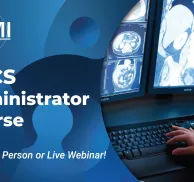Medical imaging departments are where high-stakes decisions meet high-speed workflows. Radiologic technologists, computed tomography (CT) and magnetic resonance imaging (MRI) techs, sonographers, mammographers, nuclear medicine technologists, and imaging leaders work at the intersection of patient emotion, time-critical protocols, and exacting quality standards. When the pace is relentless and support is thin, mental strain can harden into burnout that erodes well-being, team culture, and even safety.
Beyond merely sustaining the workforce, prioritizing mental health in the workplace safeguards patients by supporting clearer thinking, steadier communication, and consistently high-quality images. The following sections explore what drives burnout in imaging, how to recognize work burnout symptoms, and practical strategies for professionals and employers to build healthier, more resilient organizations.
Why Mental Health in Medical Imaging Deserves Attention
Imaging teams carry a unique blend of cognitive, technical, and emotional burdens that can accumulate over time if not managed proactively. Burnout is common yet variable across settings and roles. According to a comprehensive review on burnout prevalence and drivers among radiologic technologists, overall burnout prevalence ranged 30% to 70% across studies. Emotional exhaustion, depersonalization, and low personal accomplishment were the key types of burnout measured.
The Demands of Working in High-Stress Healthcare Environments
Imaging professionals operate in environments where urgency is routine. For instance, a trauma CT arrives between back-to-back outpatients. Meanwhile, a mammography patient needs both reassurance and precision.
Add to the mix complex equipment checks, contrast protocols, radiation safety considerations, and evolving accreditation requirements, and the cognitive load only intensifies. The emotional labor can be equally intense; this entails supporting anxious patients, discussing sensitive findings, and navigating family dynamics, often within compressed appointment slots.
How Burnout Impacts Both Professionals and Patient Care
When chronic stress goes unaddressed, its impact ripples through the entire care pathway. Clinically, burnout can dull situational awareness and sap attention to detail while tempting shortcuts — which can compromise image quality or delay critical diagnoses.
Personally, it shows up as fatigue, irritability, or detachment and professionally as lower job satisfaction, more sick days, or a desire to leave the field. Health systems then face the downstream effects: staffing gaps, onboarding costs, and strained team dynamics that further amplify stress for those who remain.
Common Causes of Burnout for Imaging Professionals
Burnout seldom stems from a single factor. It’s usually the cumulative weight of structural, operational, and emotional stressors.
Long Hours and Irregular Shifts
Extended shifts, call rotations, and holiday coverage can disrupt sleep and recovery time and generally make life planning difficult. Imaging often runs 24/7, and technologists may bounce between day, evening, and night coverage. Without predictable scheduling and adequate recovery windows, fatigue compounds, and performance inevitably suffers.
High Patient Volumes and Productivity Pressures
Throughput targets and tight appointment windows push teams to move faster while maintaining precision. The tension between speed and quality is constant. Every extra minute with a patient improves rapport and positioning, but every delay backs up the schedule. Over time, the pace can drain empathy and heighten frustration.
Emotional Toll of Diagnosing Serious Conditions
Imaging professionals witness the full spectrum of human vulnerability — discovering a suspicious mass, scanning a child with a rare disorder, or imaging a loved one’s last hours in the emergency department. Even when technologists do not deliver final diagnoses, they often read patient emotions in real time and bear silent witness to outcomes. This moral and emotional exposure can lead to compassion fatigue.
Limited Staffing and Resource Constraints
Vacancies, hiring freezes, or sudden leaves strain the remaining team. Supply shortages alongside equipment downtime and room turnover bottlenecks add friction to already tight workflows. When staffing and resources don’t match demand, technologists shoulder more tasks with less support, making even routine days feel like controlled chaos.
Recognizing Mental Strain and Work Burnout Symptoms
Early recognition of work burnout symptoms empowers early intervention for yourself, your peers, and your team.
Physical Signs: Fatigue, Headaches, and Sleep Issues
Common physical signs of burnout include:
Chronic exhaustion
Tension headaches
Gastrointestinal discomfort
Disrupted sleep patterns
Technologists may rely on caffeine to push through afternoons or find that off-days never feel restorative. Persistent physical work burnout symptoms warrant attention — not just because they are uncomfortable but also because they can impair focus and reaction time.
Emotional Signs: Irritability, Anxiety, and Detachment
Irritability and impatience with patients or coworkers, difficulty “turning off” after a shift, or a sense of emotional numbness may indicate mounting strain. Some people experience increased anxiety before work or dread when schedules drop. Others detach, losing the sense of meaning that once made the job rewarding.
Professional Signs: Decline in Job Satisfaction and Performance
Missed details, more frequent mistakes, or diminishing professional pride can signal that resources are depleted. You may notice lower motivation for continuing education, reluctance to volunteer for projects you once enjoyed, or a sense that you’re perpetually behind despite working harder than ever.
When Stress Crosses Into Clinical Depression or Anxiety Disorders
Burnout is not necessarily a clinical diagnosis, but chronic, unmanaged stress can contribute to clinical conditions that deserve professional care. Warning signs include:
Persistent low mood
Loss of pleasure in usual activities
Hopelessness
Panic symptoms
Thoughts of self-harm
If you or a colleague experience these, reach out to a licensed mental health professional or employee assistance program (EAP) promptly. In an emergency, call a hotline or local emergency services.
The Ripple Effect of Burnout in Healthcare Settings
Burnout is personal, but its impact is organizational.
Increased Risk of Errors in Patient Imaging
Fatigue and cognitive overload can impair:
Positioning
Protocol selection
Contrast timing
Post-processing
Even small lapses, like skipping a second patient identifier or mis-keying order notes, add risk. Departments must view error prevention not only as training and checklists but also as staffing, scheduling, and recovery time.
Higher Staff Turnover and Shortages
When burnout drives technologists and leaders to leave, remaining staff absorb the workload. Recruiting and onboarding replacements take time, during which morale and performance may dip further. The cycle can prove costly, financially and culturally.
Strained Communication Within Healthcare Teams
Short fuses and constant time pressure degrade communication. Handoffs become terse, interdisciplinary relationships fray, and willingness to speak up about safety concerns may decline. Psychological safety — critical for catching near-misses — depends on trust and adequate breathing room.
Reduced Quality of Patient Care and Satisfaction
Patients sense rushed encounters and fragmented communication. Anxiety may rise and cooperation during imaging can drop; repeats may become more likely. In contrast, calm, attentive technologists help patients relax and hold still, improving both experience and image quality.
Strategies for Imaging Professionals to Protect Mental Health
At the individual level for the medical imaging professional, foundational self-care (e.g., sleep, exercise, and mindfulness/relaxation) helps restore capacity and counter chronic stress. In addition, normalizing seeking help, connection, and mentorship are key to reducing isolation. These tactics and strategies don’t fix broken systems, but they can restore bandwidth and build resilience while broader improvements take shape.
Building Healthy Work-Life Boundaries
First, work to define your “hard stops.” Decide when you will stop checking work messages and stick to it when not on call.
Protect sleep like a protocol, treating it as a non-negotiable appointment. You might use blackout curtains and a pre-sleep routine, especially after nights.
Schedule recovery with intention. Plan time for movement, hobbies, and connection the same way you’d schedule a study or a shift swap.
Practicing Stress Management Techniques (Breathing, Meditation, Exercise)
Consider the following for managing your stress and recentering yourself:
Micro-recovery between cases – Try a 60-second box-breathing cycle (4-4-4-4) or progressive muscle relaxation while the scanner reconstructs.
Movement as medicine – Even a 10-minute brisk walk before or after a shift can reset mood and energy.
Mindfulness “anchors” – Pick a cue, such as sanitizing hands or logging into the console, to trigger a mini-reset. Notice your breath, unclench your jaw, and set an intention.
Leveraging Peer Support and Professional Networks
Huddle honestly, using daily meetings to flag bottlenecks early and share small wins. After tough cases, check in and debrief with a teammate about how they’re doing.
Joining professional communities and external networks (in-person or online) can also offer perspective, career ideas, and emotional support to show that you’re not alone.
Seeking Counseling or Mental Health Services When Needed
Use EAPs and benefits, and model that utilization to set an example for others. Many plans cover confidential counseling and coaching sessions. If cost or time is a barrier, look for group options, telehealth, or community resources that fit your schedule.
It can also be valuable to find a clinician who understands healthcare. Therapists familiar with shift work, compassion fatigue, or vicarious trauma can tailor strategies.
The Role of Employers in Preventing Burnout
Burnout is often a systems problem, making organizational safeguards essential. Some ways to mitigate burnout at the practice/organizational level include:
Leadership acknowledgement and routine wellness dialogue (rounds, open forums, surveys) to reduce stigma and surface fixes early.
Workflow management (staffing coverage, smarter shift design, protected breaks, overlapping coverage for crunch periods).
Collegial culture building (regular team touchpoints) and visible wellness resources (EAP, counseling, coaching).
Additionally, a systematic review covering occupational health outcomes among musculoskeletal (MSK) radiologists frames burnout alongside other occupational hazards (like physical strain or fatigue) and argues for holistic risk reduction in the areas of staffing, workload design, ergonomic improvements, and culture.
With this in mind, here are some more specific methods for employers:
Creating Supportive Staffing Models
Right-size the schedule. Match staffing to modality demand curves and build enough flex slots to absorb add-ons without derailing the day. Stabilize shift patterns to minimize rotation whiplash and ensure protected recovery windows after call or nights.
Invest in cross-training thoughtfully. Cross-trained staff create agility, but training should also come with the time and coverage needed.
Offering Access to Wellness and Mental Health Programs
Make support visible and easy. Centralize resources — EAP, counseling, financial wellness, child/elder care support — and remind staff regularly.
Bring services to the unit. On-site or virtual options and short, practical sessions during work hours increase access.
Finally, train leaders to recognize strain. Supervisors need skills to spot early warning signs and to respond with empathy and practical solutions.
Encouraging Regular Breaks and Realistic Workloads
Honor the pause. Protected breaks are a patient safety strategy, so build them into daily staffing plans and backfill creatively.
In addition, encourage quick resets after emotionally heavy encounters, treating them like clinical “time-outs” rather than personal indulgences.
Audit invisible work, too. Phone triage, PACS troubleshooting, and patient education consume time, so account for them when setting targets.
Promoting a Culture of Openness Around Mental Health in the Workplace
Model vulnerability at the top. When leaders share their own strategies and stories, stigma drops and help-seeking rises. This means offering praise for speaking up, debriefing errors without blame, and inviting ideas from every role — especially early-career technologists. Also recognize and reward recovery behaviors by celebrating teams that redistribute load, escalate early, and support colleagues through tough shifts.
Real Stories From Imaging Professionals
Lived experience brings the issue into focus. The following account from imaging leader Brenda DeBastiani illustrates how burnout can creep in and how intentional change can restore well-being.
Having worked at the same facility since 1989 as a rad tech, CT tech, supervisor, and then promoted to director of imaging in 2013, she had always loved her job — until 2019, when she decided to make a change primarily due to burnout.
“I felt undervalued, unsupported, over-stressed, and generally unhappy in my career,” DeBastiani says, noting workweeks that exceeded 60 hours. Becoming cynical and “numb,” she adds, “I was still giving 110% of myself, but dying a little bit inside. I had a high-pressure job with lack of control. Expectations were unclear; blurry dotted lines were added with no increase in pay. I felt taken advantage of, unheard, and uncared for.”
Thus, she began seeking a new position in Florida, where she knew she wanted to someday retire. Holding out for the right opportunity, she kept a “mask” on at her current role, but pretending to be content only created additional stress on herself. As she puts it, “I was quietly cracking and didn’t even know it.”
Finally, DeBastiani accepted a job in Spring Hill, Florida, as the director of imaging at a smaller hospital with only four modalities instead of 10, plus fewer direct reports/indirect reports. When leaving her former facility, her colleagues were shocked — but coming into her new role brought a feeling of almost immediate relief. Working a standard 40 to 50 hours per week, she was able to have a life outside of work and focus on self-care, exercise, and enjoying time with family and new friends. Despite leaving behind some friends and a beloved family home, along with 33 years of tenure and a huge PTO bank, the rejuvenation of spirit she received from changing jobs was exactly what she needed.
“Don’t get me wrong, I still have stress, even now. But because I have time to focus on myself, I am able to better handle stress,” she says. “After six years, I finally feel like myself again … It took time to recover. Being in the right job with a supportive, caring boss as well as having the right mindset is crucial to overcoming burnout. I feel so blessed that I was able to take the leap!”
For departments and individuals, DeBastiani’s story highlights that:
Scope and control matter. Smaller scope and clearer lines of authority restored autonomy and reduced overload.
Supportive leadership is decisive. Feeling heard and valued transforms the same tasks into a sustainable workload.
Recovery takes time — and intention. Boundaries, movement, social connection, and a role that fits your season of life all contribute.
Transparency beats the “mask.” Peers were surprised by DeBastiani’s departure, underscoring the need for open dialogue about strain before it becomes a breaking point.
Prioritizing Mental Health in Imaging Careers
Regardless of burnout prevalence, with shared ownership, imaging can be both high-performance and humane.
Burnout Is Common — but It’s Not Inevitable
The pressures driving burnout are real, but they can be mitigated through smarter staffing, deliberate recovery, and steady peer support. Naming the problem is the first step; designing workflows and cultures that respect human limits is the next.
Both Professionals and Employers Share Responsibility for Wellness
Technologists and leaders can cultivate personal practices that preserve energy and focus, while organizations must shape conditions through schedules, resources, and culture that make healthy practices possible. Neither side can solve burnout alone.
A Healthy Imaging Workforce Means Better Care for Patients
When imaging professionals are rested, supported, and engaged, they interact more smoothly with patients and clinical partners while following protocols more consistently. The result is safer care, fewer repeats, and higher satisfaction for patients and staff alike.
Conclusion
Imaging will always ask for excellence under pressure. The challenge — and the opportunity — is to build systems and habits that make excellence sustainable. When departments treat mental health in the workplace as a core element of quality, not a side project, everyone benefits: Technologists feel human again, leaders build stable teams, and patients receive the calm, careful care they deserve.







